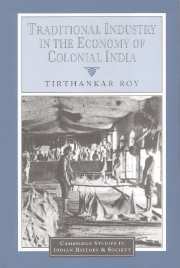5 - Brassware
Published online by Cambridge University Press: 05 July 2009
Summary
Metal craftsmen in India can be divided into two broad classes: the iron workers mainly engaged in the manufacture and servicing of tools; and the brass, bronze, and copper workers producing utensils. The second group forms the subject of this chapter. It produced a consumer good like cloth; and, not unlike cloth, the product was highly diversified, ranging from the utilitarian to objects of display. The specific skills involved did not face serious threat from mechanized processes. Also, the product being bulky, transport costs would not have justified imports. The dominant source of change in this craft, therefore, was a commercialization that involved locally produced wares. Pursuing this theme, this chapter describes sharper intra-craft competition, consequent pressures to raise productivity and quality, institutional and technological changes as a result of the latter, and, finally, the part that subtle conflicts between utility and craftsmanship played in these adaptation processes.
The first section deals with general developments of the brassware market. The next two sections outline the constraints that these very developments imposed on the artisans, the second dealing with the utilitarian, and the third with that branch of the industry intensive in craftsmanship. The fourth section describes institutional and technological changes, partly in consequence of these tendencies in demand, and partly in consequence of broader developments in location and input markets.
- Type
- Chapter
- Information
- Traditional Industry in the Economy of Colonial India , pp. 128 - 154Publisher: Cambridge University PressPrint publication year: 1999

